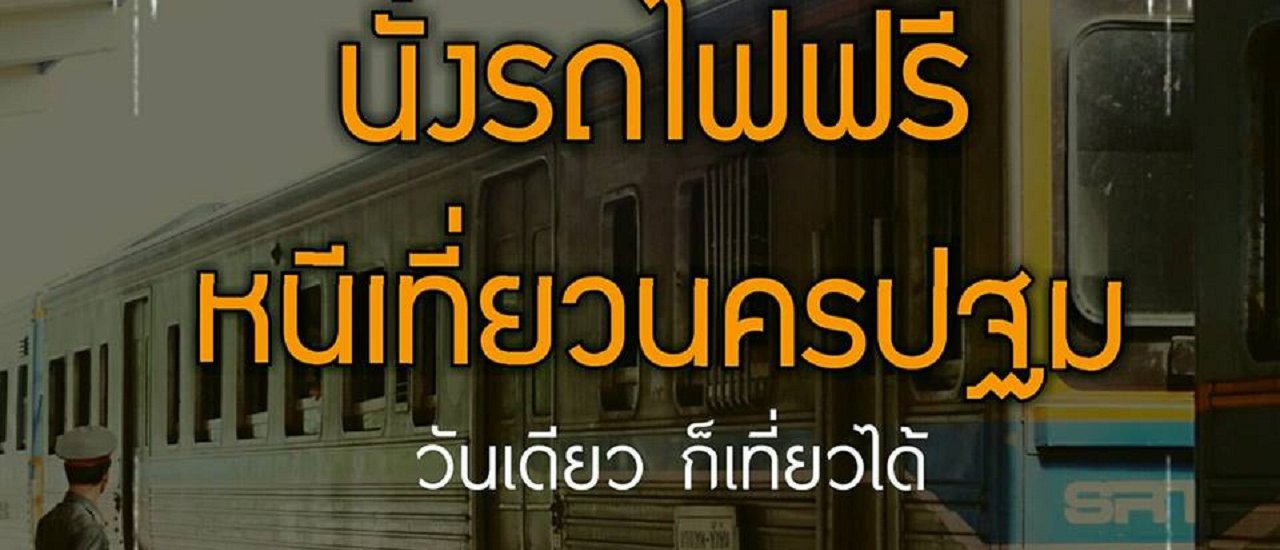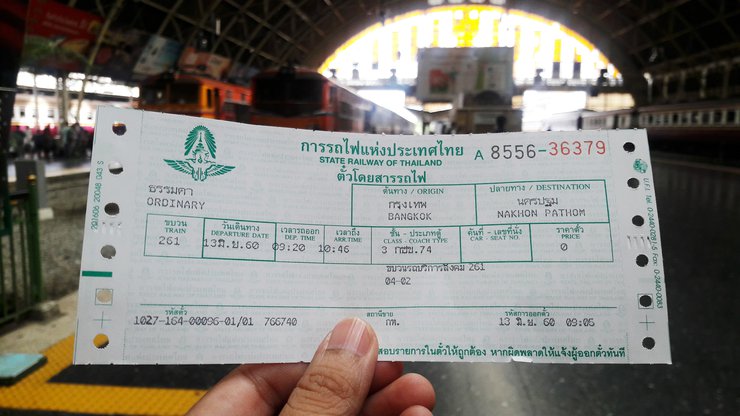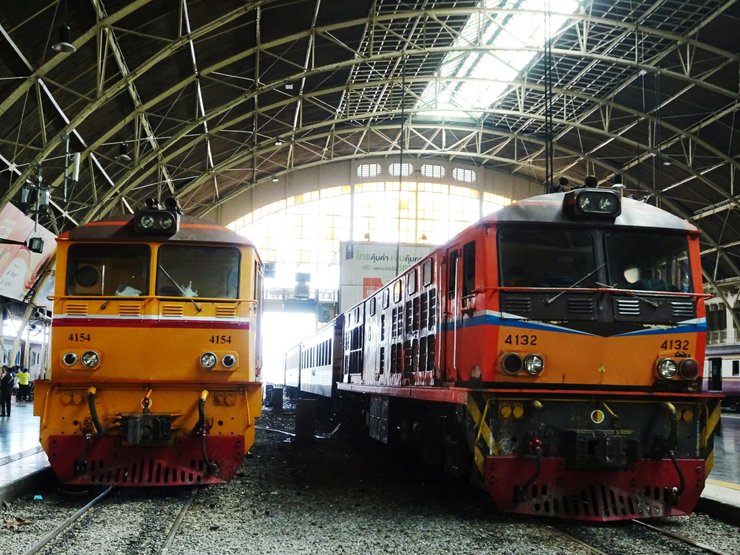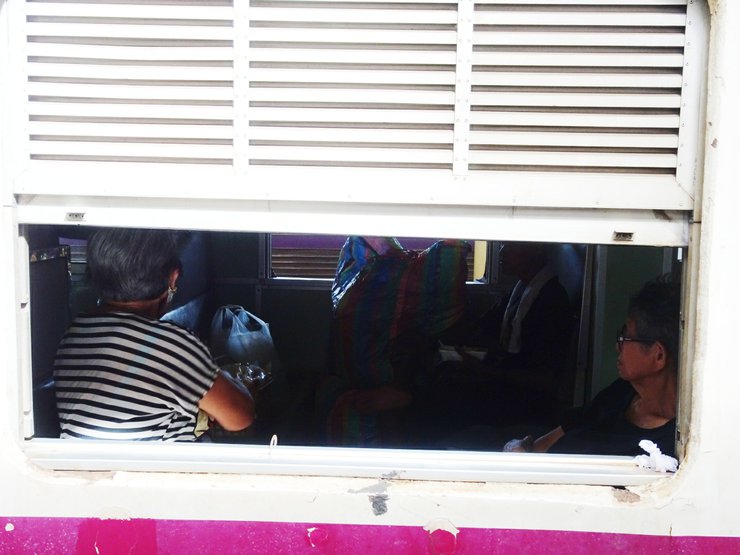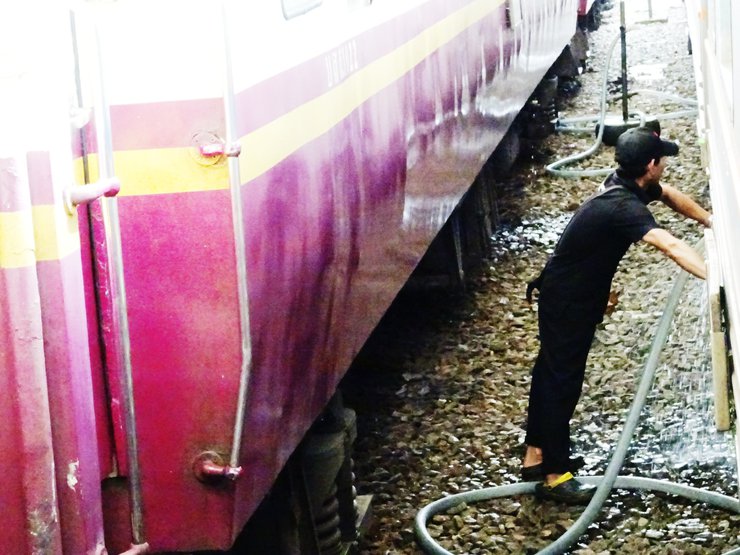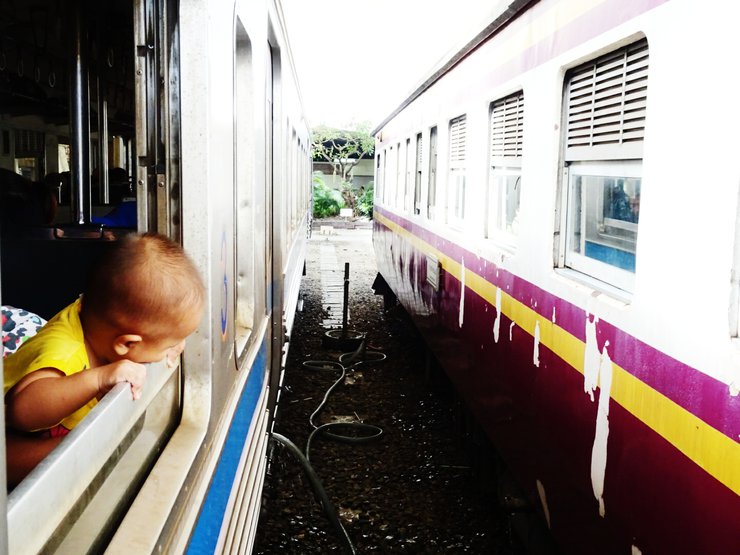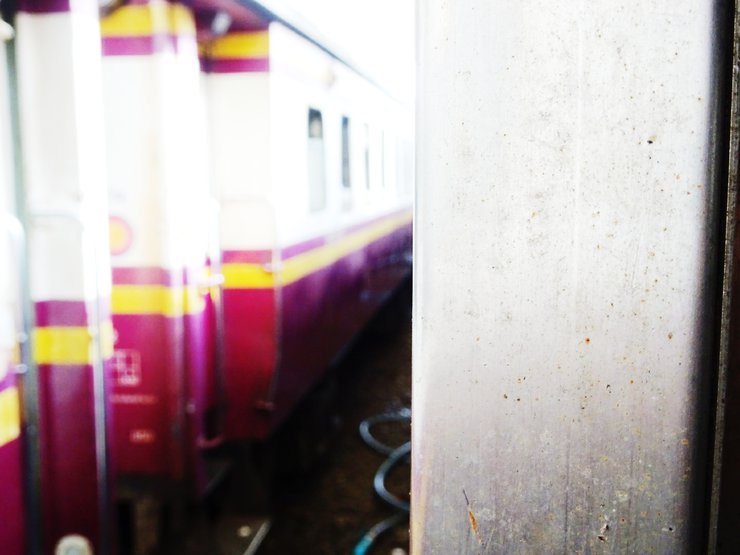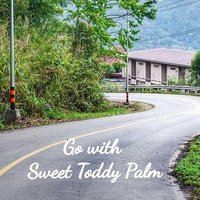Travel? Haha, who are you running from? I usually travel alone anyway. No, no, I just made it up to rhyme. It's been a long time since I wrote a review because I'm lazy. Lately, I haven't even put much content in my writing, just focusing on pictures (why am I like this?). As always, I'm still the same, still traveling by train. How much money have I spent on traveling to faraway provinces? This time, let's take a one-day trip to a nearby province by taking the free train, which is still with us as always. I think the free train will be with us until the end of the year.


A quick stopover on a tour bus wasn't enough to satisfy my wanderlust. I almost missed the opportunity to pay respects at the Phra Pathom Chedi. This time, I'm dedicating a whole day to exploring Nakhon Pathom. I'll wander around, taking photos as I go. Since I'm a bit strapped for cash right now, I'll focus on sightseeing rather than indulging in the local cuisine. I'll be back to eat my way through the city when my pockets are a bit deeper. Nakhon Pathom has an abundance of delicious food, so much so that I could easily spend a fortune here. The evening market at Phra Pathom Chedi was particularly tempting, but I had to leave early. Today, I'm focusing on exploring and taking photos, which is tiring enough. I've captured plenty of images to share with you. Honestly, you could even get here and back for 300 baht if you don't overindulge in food.





Enjoy a free train ride to Nakhon Pathom within a day. No need to leave early like the tour train. You can leave a little later because today the free train leaves at 9:20 am. Arrive when the train is about to leave. Hair is messy, ears are up, running without thinking. The train is about to leave. No makeup, bare face. Travel by train, outbound train 261, departure time 09.20, arrival 10.46 am. With a little time and a little extra time, the return train 262 departs at 17.16 and arrives at 17.00 pm. With a little time and a little more extra time.



Went to take some beautiful photos, but today I don't have many photos of myself because I'm sunburnt.




Upon arriving in Nakhon Pathom, we first paid our respects at Phra Pathom Chedi. As we approached the chedi, we encountered a friendly cat, prompting us to pause and say hello.

The Phra Pathom Chedi, a large bell-shaped stupa, is a significant religious site in Thailand. Located within the Wat Phra Pathom Chedi Ratchawaramahawihan temple, it is believed to enshrine relics of the Buddha.



The weather is scorching today, but thankfully it's not raining. The clouds are adorable and fluffy, resembling giant cotton candy.





The place can get crowded, especially on weekends. However, when we visited on a weekday, it was relatively empty.

















I prefer visiting the temple on weekdays. Weekends must be crowded, so I can find more angles to take pictures in peace and quiet.












It's a shame that the museum is closed to the public.



The temple's unique collection of Buddha statues in various postures, some of which are rarely seen, was particularly impressive and provided valuable insights into Buddhist iconography.
Awaiting the mango harvest
Receiving a gift of a mango
The figure is seated in a cross-legged position, with the left hand resting on the left thigh and the right hand placed palm up on the right knee. In the palm of the right hand is a mango.

Pang Pattakit
Consuming a meal
The presiding deity for those born in the ninth month.
The Buddha sits in a cross-legged position, his left hand supporting the alms bowl placed on his lap. His right hand reaches into the bowl, in the act of taking food.

My anchor
Consuming a gall-nut fruit
The Buddha is seated in the full lotus position, with his left hand resting on his lap and his right hand placed palm up on his right knee, holding a jujube fruit.

The posture of the chief disciple
Identifying the main disciples
The Buddha image for those born in the year of the Dog
The Buddha is seated in the full lotus position, with his left hand resting palm up on his lap and his right hand raised, pointing forward. This gesture signifies the proclamation of the chief disciples to the assembly of monks.

Posture of Contemplation
The Reflection
Presiding deity for those born on Friday
Standing posture, both hands raised to the chest, right hand over left hand, in a contemplative gesture.

The Relics of the Buddha's Hair
Bestowing his hair relics upon the two merchants
The figure sits in a cross-legged position, with the left hand resting palm up on the lap. The right hand is raised to the head in a gesture of adjusting the hair.


There are many more hidden truths to be discovered. Come and explore them with us.
After paying respects to the Buddha and taking photos, take a moment to relax and enjoy the peaceful atmosphere. The weather was perfect on the day of our visit, with beautiful skies and fluffy clouds. However, the sun was also very strong, so be prepared for the heat. We weren't able to visit many places due to our tight schedule, but our main goal was to take photos at the Sanam Chan Palace. To get there, we took a motorbike taxi from the entrance of Phra Pathom Chedi for 40 baht. The taxi dropped us off right in front of the palace. If you're coming from the train station, you can also take a taxi from there. However, we recommend paying respects at Phra Pathom Chedi first since you're already there. Be prepared for a long walk if you enjoy taking photos, as the palace grounds are very extensive. We're not sure about other transportation options like tuk-tuks or buses, but the security guard at the temple told us that a motorbike taxi is the quickest way to reach the palace. Please be mindful of the rules and regulations, especially regarding attire and photography. Photography is only allowed outside the palace, and it's strictly prohibited inside. In some areas, you can enter and listen to讲解员讲解历史故事,了解更多知识。






The sentence is already in English and does not require translation.

The reviewer would like to reference factual information to avoid any discrepancies. They acknowledge the information provided in the brochure given by the staff and appreciate it. However, they note that the information may not be complete for all locations due to the extensive walking involved, which can lead to difficulty in recalling specific details and characteristics, especially since the houses appear similar. The reviewer apologizes for any potential inaccuracies.
The Marie Rajarajeswari Rajabhat Palace is a two-story palace built from golden teakwood and painted red. The roof is covered with kite-shaped tiles. The architectural style is neoclassical, inspired by Western countries, but some elements have been adapted to suit the hot climate.
The Marirajrattaballang Residence is a two-story building with a golden teakwood facade painted in red and a tiled roof. Architecturally, the building is a European neo-classical style with modifications to suit the tropical climate.



This palace was built alongside the Chaleemongkolasana Palace, connected by a covered walkway bridge extending from the upper floor at the back of the Chaleemongkolasana Palace across the moat to the front upper floor of the Marirat Ratcharat Banglang Palace. The bridge has a tiled roof, walls, and glass windows on both sides along its entire length. King Rama VI commissioned the construction of this palace around 1916, with Prince Ithithepsan Kritakara as the architect.
The covered walkway, constructed to connect the Jalimangalasana Residence and the Marirattaballang Residence, spanned the moat and featured a tiled roof with windows along its entire length. Built around 1916 under the direction of King Rama VI, the throne hall was designed by Prince Iddhi Debasan Kritakarana.



This is a highly popular spot, and visitors often take multiple photos from this angle. However, photography is only permitted from the outside; the interior is off-limits.



The Chaleemongkol Asana Palace, the Marirat Ratcharat Balang Palace, and the connecting bridge pavilion are a group of buildings commissioned by King Rama VI. Inspired by the play "My Friend Jarlet" by Arnold Golsworthy and E.B. Norman, the King translated the play into Thai under the title "Mit Tae" (True Friend). He then named the Chaleemongkol Asana Palace and the Marirat Ratcharat Balang Palace after characters in the play.
The Jalimangalasana and Marirajrattaballang Residences were inspired by the play "My Friend Jarlet" by English playwrights Arnold Golsworthy and E. B. Norman. King Rama VI of Thailand translated the play into Thai under the title "True Friend." The names of the two residences were derived from the play's characters.

Chaleam Mongkol Asana Royal Residence

The Chalimongkol Asana Palace is a small castle-like structure that combines French Renaissance and English half-timbered architectural styles, adapted to the Thai climate. King Rama VI commissioned its construction around 1908. The architect was Prince Itithepsan Kridakara.
The Jalimangalasana Residence, a French Renaissance and English half-timbered style building, resembles a small castle. Designed by H.R.H. Prince Lddhi Debasan Kritakarana, the residence was constructed around 1908 for H.M. Rama VI. Modifications were made to suit Thailand's tropical climate.

This palace was originally called "Phra Tamnak Le" in 1915. King Rama VI graciously bestowed the name "Phra Tamnak Chaleemongkol Asana" and ordered a royal ceremony to be held on February 3, 1917.
This building was formerly known as the Jarlet Residence. In 1915, King Rama VI of Siam bestowed upon it the name Jalimangalasana Residence. A housewarming ceremony was held on February 3, 1917.

The Chalimongkol Asana Palace is a two-story building painted in an eggshell color with a red tile roof. The upper floor houses a royal study, a bedroom, and a bathroom. The lower floor's west wing served as a waiting room and temporarily housed the office for the publication of the Dusit Samit Weekly newspaper.
This royal residence served as the temporary abode of King Rama VI when he commanded the Wild Tiger Corps during military exercises at Sanam Chan Palace. The king also favored residing in this palace during his visits to Sanam Chan Palace towards the end of his reign.
The Jalimangalasana Residence: A Detailed Description
The Jalimangalasana Residence is a two-story structure, adorned with a light yellow paint scheme and a contrasting red-tiled roof. The upper floor houses a writing room, a bedchamber, and a bathroom, providing private spaces for contemplation and rest. The first floor's west wing accommodates a waiting room and the temporary office of the weekly Dusit Smit Magazine, facilitating both public interaction and administrative tasks.
King Rama VI frequently resided in this building during his command of the Wild Tiger Scout exercises at Sanam Chandra Palace. Notably, towards the end of his reign, the King continued to choose this residence for his visits to Sanam Chandra Palace.

Ya Li Monument
Ya Lae was a mixed-breed dog with a white and black spotted coat, floppy ears, and a curled tail. Born in the Nakhon Pathom Provincial Prison, he belonged to Luang Chai Anya (Po Kehanan), the prison warden at the time (later bestowed the title of Phra Phutthakhet Anurak). During a visit to the prison by King Rama VI, the king noticed the adorable puppies and was gifted Ya Lae by Luang Chai Anya. The king accepted the dog and named him "Ya Lae".
Ya Le, a beloved royal dog raised in the Grand Palace, was known for her intelligence and unwavering loyalty to King Rama VI. On July 18, 1913, after the King's visit to Wat Benchamabophit and Wat Pho, Ya Le slipped out of the palace grounds and was tragically shot and killed on the street near Wat Pho.
The loss of "Ya Lae," the beloved dog of King Rama VI, caused him immense grief. As a tribute, His Majesty graciously ordered the construction of a bronze monument of "Ya Lae" in front of the Chaleemongkol Asana Palace. He also penned a heartfelt eulogy, reflecting his profound sorrow, which was inscribed on a bronze plaque at the base of the monument.
Jarlet, a black and white hybrid dog with a bushy tail and drooping ears, was born in a Nakhon Pathom prison. The dog belonged to the chief prison warden, Luang Jaya Aya (Pho Gehanandana), who was later appointed to phra Buddha Kshetra Nuraksha. During a visit to inspect the provincial prison, H.M. King Rama VI noticed the adorable puppy. Luang Jaya Aya presented the puppy to the king, who named it "Jarlet."
Raised within the royal palace grounds, Jarlet remained constantly by the side of His Majesty the King. Renowned for its wisdom and unwavering loyalty, the dog swiftly ascended to the position of the King's most cherished companion.
On July 18, 1913, King Rama VI of Siam departed from the Ambara Residence to perform merit-making rituals at the Marble Temple and the Giant Swing during the Buddhist Lent Day. In the evening, while the King stopped for dinner at Saran Rom Palace, Jarlet, a royal page, left the palace grounds without authorization. Jarlet's body was later discovered with a gunshot wound on the roadside between the Giant Swing and the Royal Palace.
King Rama VI's profound grief over the loss of his cherished dog, Jarlet, led him to commission the Jaelet Statue, cast in smoked copper and prominently displayed at the Jalimangalasana Residence. This poignant tribute served as a testament to the king's deep affection for his loyal companion. Furthermore, King Rama VI penned a heartfelt eulogy, engraved on a copper plaque at the statue's base, eloquently expressing his sorrow.

This monument to King Rama VI was erected by the Nakhon Pathom Provincial Scout Committee to honor and commemorate his immense kindness towards the Thai people. Notably, the King was the founder of the Wild Tiger Corps and the Boy Scouts of Thailand in Nakhon Pathom Province. He also donated funds for the construction of the monument. The Fine Arts Department was consulted for the design and casting of the bronze statue, which depicts the King in his Wild Tiger Corps uniform, seated on a field chair, with his right hand holding a pen and his left hand holding a notebook for recording Wild Tiger Corps maneuvers.
The Supreme Patriarch of Thailand presided over the laying of the foundation stone for the royal monument on March 3, 1982. The statue was then brought from the Fine Arts Department and placed on its pedestal on November 24, 1983. His Majesty the King graciously appointed Her Royal Highness Princess Maha Chakri Sirindhorn to represent him in the opening ceremony of the King Rama VI Monument on April 4, 1986.
Monument to His Majesty King Vajiravudh
The H.M. King Vajiravudh Monument in Nakhon Pathom, Thailand, commemorates the king's contributions as the founder of the Wild Tiger Scouts and the Thai Boy Scouts. The monument was constructed by the Nakhon Pathom Province Boy Scouts Committee with donations from government officials, business leaders, the public, and local scouts. The Fine Arts Department assisted in creating a one-and-a-half-size bronze statue of King Rama VI in his Wild Tiger Scout uniform, seated on a field chair with a pen in his right hand and a notebook in his left, recording events during a Wild Tiger Scout exercise.
The Supreme Patriarch presided over the foundation stone laying ceremony on March 3, 1982. On November 26, 1983, a ceremony was held to install the Royal Statue, brought from the Fine Arts Department, on its prepared mount. H.R.H. Princess Maha Chakri Sirindhorn graced the monument's opening ceremony on April 4, 1986.
Phra Thinang Phiman Phathom
The Phiman Phatthana Throne Hall was the first royal residence constructed within the Sanam Chan Palace in 1907. At the time, King Vajiravudh was still Crown Prince and held the title of Somdet Phra Borommarachathirat Siam Makut Rajakumarn.
The architectural style of Phiman Pithak Throne Hall is a two-story Western-style building. The original walls were made of wood, but in 1913 they were replaced with concrete. The eaves, ventilation openings, awnings, and balcony railings are exquisitely decorated with gingerbread-style fretwork. Inside the Phiman Pithak Throne Hall, there are various rooms with nameplates still visible today, such as the Royal Bedchamber, the Bathing Room, the Royal Study, the Royal Wardrobe, and the Dining Room. Additionally, there is the Phra Chao Room, which houses a Buddha statue in the First Sermon posture. King Rama VI graciously ordered the construction of a ceremony hall for casting this Buddha statue next to the Saman Chakkhimuk Maet Throne Hall. He also raised a white umbrella over the Buddha statue and designated the Phra Chao Room as the main prayer room of the Sanam Chan Palace. Inside the Phra Chao Room, there are murals by Phraya Anusasanachitrakorn (Chan Chitrakorn). Notably, the location of the Phra Chao Room is significant and interesting. The Tourism Authority of Thailand (TAT) has declared it an UNSEEN attraction of Nakhon Pathom Province because the Phra Chao Room offers a direct view of Phra Pathom Chedi and the Ganesha Shrine.
King Rama VI used the Piman Pathom Throne Hall as his main residence for receiving dignitaries and foreign guests. Currently, the Piman Pathom Throne Hall houses a permanent exhibition in honor of King Rama VI and Princess Bejaratana Rajasuda. The exhibition is divided into several rooms, including:
1. The Genesis of Strategy Chamber 2. The Chamber of His Royal Highness Prince Theerarat 3. The Chamber of His Majesty's Heart 4. The Chamber of the Reign of Development 5. The Chamber of the First Royal Faith
The Bimarn Pathom Throne Hall, constructed in 1907 at Sanam Chandra Palace, served as the first throne hall during the reign of H.M. King Rama VI, then H.R.H. the Crown Prince.
The throne hall, a two-story Western-style building, underwent renovations in 1913, replacing its original wooden walls with concrete. This hall boasts exquisite decorations, particularly in its eaves, ventilators, awnings, and balustrades, featuring intricate fretwork in a gingerbread design. Inside, numerous rooms retain their original signage, including the Buddha Room, Bedchamber, Lavatory, Library, Closet, and Dining Room. Notably, the Worship Room houses a Buddha statue in the pose of Giving the First Sermon, commissioned by King Rama VI. The king also oversaw a ceremony placing a white tiered umbrella above the statue and designated the room as the Buddha room for Sanam Chandra Palace. This room's unique location, offering a perfect alignment of Phra Pathom Chedi and the Ganasha Shrine, has earned it recognition as an UNSEEN area of Nakhon Pathom Province by the Tourism Authority of Thailand.
This throne hall served as the primary residence of H.M. King Rama VI, where he held meetings with dignitaries and received guests. In honor of both the King and H.R.H. Princess Bejararatana Rajasuda Srisobhabannavadi, the throne hall now houses an exhibition divided into several rooms.
- The Genesis of Strategy - The Philosopher-Monarch
- His Life's Work: The Era of Development
- The First Faith


Seek shade under the trees when the sun is hot.


Significant buildings in the Sanam Chan Palace
King Rama VI graciously ordered the construction of a teakwood house in Sanam Chan Palace to serve as accommodation for royal staff and as a functional building for various roles. The house is a single-story building with a high foundation. The architectural style is a hybrid of traditional Thai and Western architecture. The houses are arranged in a row around the moat of Sanam Chan Palace and in other areas within the palace grounds, such as:
Grand Residence at Sanam Chandra Palace
King Rama VI of Thailand commissioned the construction of several teakwood houses at Sanam Chandra Palace. These houses served as residences for officials and hosted various functions. Designed in a hybrid Thai and Western style, the single-story structures feature high, open basements. Scattered around the palace's pond and grounds, these houses include:
The Royal Residence of Nonthaburi
The Phra Nonthikar Pavilion is a large, beautiful teakwood structure. It is a single-story building with a high foundation, painted yellow with brown trim. The pavilion is located in the outer part of the Grand Palace, on the east side. It was once the residence of Chao Phraya Dharmadhikaranadipat (M.R.W. Pum Malakul), the Minister of the Royal Household.
Phra Nondikara House
The Phra Nondikara House is a remarkable, large, single-story teakwood building with a high, open basement. The house, painted yellow with brown trim, is situated on the eastern outskirts of the palace. It was once the residence of Chao Phraya Dharmadhi Karana Dhipati (M.R. Pum Malakul), the Minister of Royal Affairs.




Phra Thinakon Pavilion
The Phra Thanesuan Residence is a single-story wooden house built on stilts with a hip roof. The house is made of teak wood and decorated with gingerbread-style fretwork. Within the residence grounds, there is an octagonal pavilion situated on a mound by the moat of the Sanam Chan Palace.
The Narai Residence was bestowed by King Rama VI upon Phraya Burut Rattana Ratchaphallab (Dr. Krairik), who held the position of Tiger Scout Adjutant. Phraya Udom Ratchabhakdi (Tho Suchiritkul) also resided there.
Phra Dhanesavara House
The Phra Dhanesavara House is a single-story structure with a high, open basement. Its roof, crafted from teak wood, showcases a traditional Thai design, adorned with intricate fretwork reminiscent of gingerbread. Within the house's compound lies an octagonal gazebo, perched atop a mound near the serene pond of Sanam Chandra Palace.
The Phra Dhanesavara House served as the residence of Phraya Purusha Ratana Rajaballabha (Naba Krairiksh), the leader of the Wild Tiger Scout Corps, and Phraya Uttama Rajabhakti (Tho Sucharitakul), as granted by King Rama VI.





The House of the Brahmin
The Royal Residence, located on an island in the moat of the Sanam Chan Palace to the northeast, is a single-story teakwood building on stilts with a hip roof decorated with gingerbread-style fretwork.
Phra Garihapati House
The Phra Garihapati House stands on an island within the pond of Sanam Chandra Palace, facing northeast. This single-story building features a high, open basement. Its roof, adorned with intricate fretwork in a gingerbread design, exemplifies traditional Thai architecture.



The palace tour was a pleasant surprise. While photography was restricted inside, we were allowed to explore several areas. As I approached the royal residence, I noticed a staff member calling out to me from afar. She invited me to come closer, and upon reaching the residence, she enthusiastically shared her knowledge about the nutmeg tree. She explained that the fruit is edible and that while squirrels only eat the center, humans can consume the entire fruit. Her eyes sparkled with joy as she described her passion for collecting the fallen nutmeg. She revealed that she often waits for the perfect time to gather them, ensuring she collects them before the squirrels. Sometimes, squirrels even climb the residence to reach the fruit, and she willingly offers them some. The palace has numerous residences, each with a staff of 1 to 5 people. The smallest staff consists of only one person, who I observed working alone. I imagine it can get lonely at times, especially when there are no visitors passing by.
The conversation flowed effortlessly, as we shared our love for all things Thai. I, being a true Thai girl, am always up for trying new and exciting flavors, especially those with a distinctly Thai aroma. Unlike many who rely on chemical perfumes, I find them overwhelming and prefer the natural fragrances of Thailand. In fact, I have a particular fondness for the scent of squirrels, having once kept them as pets. My enthusiasm for these furry creatures was evident as I excitedly chatted with someone who shared my passion. We were so engrossed in our conversation that we almost forgot the purpose of our visit, which was to explore the palace. Instead, we found ourselves discussing the merits of "luk chan," a traditional Thai dessert made from mung beans. Our conversation was so engaging that I ended up taking a bag of "luk chan" back to my workplace in Bangkok.
This is the first time I've seen, touched, and eaten a nutmeg fruit. It smells good, I like it. Oh... I read a sign on the nutmeg tree that it only bears fruit from June to September. In case anyone wants to go, I'll give you the coordinates of the tree. I didn't follow them, but I found another tree while looking at the different houses.
Positive energy can often be easily found from the people around you.
Finding joy in the little things each day empowers both you and those around you with positive energy. Surround yourself with positive individuals, as it has a profound impact on your mental well-being.




The weather is hot, but under the shade of the trees, it is pleasantly cool.


Thap Kaeo Palace
The Tap Gaew Palace is a small, compact two-story building painted in a light yellow color. Inside, there is a fireplace, and the roof has chimneys in the Western style. The central room on the upper floor features a portrait of King Chulalongkorn (Rama V) drawn in black pencil on a marble slab above the fireplace. However, there is no record of who created this portrait.
During the reign of King Rama VI, the Thap Kaew Palace served as the headquarters for the Wild Tiger Corps during military exercises. The palace also hosted ceremonies for the bestowal of royal decorations, titles, and ranks upon civil servants. Additionally, it served as a place for the king to rest and enjoy refreshments.
The Thap Kaew Residence is a two-story structure, painted in a light green hue. The building features a fireplace with a chimney that extends through the roof, reminiscent of Western architectural styles. The second floor's central room displays a royal portrait of King Chulalongkorn (Rama V), rendered in charcoal on a white marble plate. The artist responsible for this portrait remains unidentified.
During the reign of King Rama VI, the Thap Kaew Residence served as the command headquarters for the Wild Tiger Scouts and the Light Infantry Royal Aides-de-Camp during military exercises. It also functioned as a venue for awarding medals, commissioning government officials, and occasionally as a place for leisure and tea gatherings.




Thap Khuan Royal Residence
The Thap Khuan Palace is a perfect example of a traditional Thai house complex. Designed and supervised by Phraya Witsawakam Silpakit (Noi Silpa), the palace comprises eight Thai houses connected by verandas. A Chan tree provides shade in the center of the courtyard.
The Royal Residence of Thap Khuan is a wooden structure with intricate fretwork designs on the walls. The original thatched roof has been replaced with clay tiles, and the gables and supporting beams are beautifully carved. All parts of the building, including the exterior floor, are made of teak wood, using traditional Thai carpentry techniques. This type of Thai house is classified as a "Khabhadi" house, which has all the necessary components and is aesthetically pleasing in its proportions.
King Rama VI of Siam ordered the construction of this palace to preserve the ancient Thai architectural style. He also held a royal ceremony to inaugurate the palace on January 25, 1915, and stayed there for one night. During military exercises, the palace served as the headquarters for the Tiger Scouts of the Royal Guard's Light Infantry Regiment.
Thap Khwan Residence
The Thap Khwan Residence is a traditional Thai-style house designed and constructed by Phraya Visukarma Silprasidh (Noi Silpi). It comprises a complex of eight wooden living quarters arranged around a central platform. A large Siamese In-chan tree stands prominently in the center of the platform.
The Thap Khwan Residence is a wooden structure. Its paneled walls are adorned with intricate Thai classical motifs. The original thatched roofs, once capped with baked-clay tiles, were later replaced entirely with baked-clay tiles. The eaves and roof props are exquisitely fretted. All eight quarters, including the central platform, are constructed from teakwood, with planks joined using an ancient Thai technique. The architectural style is typical of wealthy residences, featuring all essential components in harmonious balance.
King Rama VI commissioned the construction of this residence to preserve the traditional Thai architectural style. The housewarming ceremony was held on January 25, 1915, and the King spent the night there. The building also served as the command headquarters for the Heavy Infantry Royal Aides-de-Camp during a military exercise involving the Wild Tiger Scouts.


The line between a peaceful corner and a lonely one is truly thin.


Another magnificent and exquisitely ornate royal pavilion that left us in awe. The intricate details and meticulous craftsmanship truly embody the essence of Thai artistry.
Vajira Rmaromya Pavilion
The Wachira Rarmmaya Pavilion is a twin pavilion to the Sammakhi Mukhamat Pavilion. It was built by King Rama VI in 1917. The pavilion is a two-story Thai-style building with a sloping roof covered with glazed tiles. It is decorated with elaborate gable ornaments, including finials, bargeboards, and naga serpents. The stairs leading up to the pavilion are decorated with carvings that resemble folded royal decrees. The ends of the stairs are carved with lotus buds and connected by a curved sash. The sash is surrounded by a halo of floral motifs that radiate outwards. The frame is decorated with a garland of rice sheaves. The east gable is carved with a three-headed Erawan elephant. On the elephant's back is a saddle with the emblem of King Rama VI. The gable is surrounded by floral motifs and gilded. The lower part of the south gable between the front pillars is decorated with intricate honeycomb patterns. The ceiling of the upper floor of the Wachira Rarmmaya Pavilion is painted in a deep red color and decorated with carved and gilded wooden flowers. The ceiling of the lower floor is also painted in a deep red color and decorated with gilded stars. The pillars of the pavilion are decorated with lotus bud motifs at the top.
King Rama VI used the Vajirayana Royal Residence as his writing room and occasional residence. Currently, the bedroom and writing room have been arranged to resemble the atmosphere during the reign of King Rama VI.
Vajiravirama Throne Hall
The Vajariramaya Throne Hall, constructed in 1917 under the reign of King Rama VI, is an annex to the Bimarn Pathom Throne Hall. The Thai-style structure features a double-tiered roof adorned with glazed colored tiles. The gable apex, adorned with tooth-like ridges and a Naga in a concave posture, adds to the grandeur of the throne hall. Two staircases, one on each side, lead to the hall. A long portico on the south connects the upper floor to the Bimarn Pathom Throne Hall. The southern and western gables are exquisitely decorated with a traditional letter box motif, featuring lotus bud ends and a curved line shoulder strap. Circular rays of light emanate from the center, surrounded by funnel-like float fillers. The eastern gable depicts a three-headed elephant with a howdah bearing the engraved and lacquered Vajiravudh insignia. The floor is adorned with a Thai pattern of blue glass on both sides. The area beneath the pediment is embellished with intricate Thai-style carvings. The ceiling of the top floor is dark red, adorned with carved and lacquered wooden flowers. The lower floor ceiling, also dark red, features star decorations. The lacquered pillars of the throne hall are decorated with a lotus in bloom pattern at the top.
King Rama VI used this throne hall as both a writing room and, on occasion, a residence. The current arrangement of the chamber bedroom and writing room reflects the style of King Rama VI's reign.








Throne Hall of Concord
The Throne Hall of Samikkimukhamat is a single-story, open-sided pavilion in the Thai style, connected to the Wachira Rmyan Hall. The two halls share a roof, which is gabled with projecting eaves on the east, west, and north sides. The roof is decorated with wooden ornaments and mirrors. The north gable features a carved image of Indra, the king of the gods, bestowing blessings. He sits in a three-peaked palace, holding a vajra in his right hand and offering a blessing with his left. He is surrounded by attendants, including gods and five groups of humans. Inside the hall, King Rama VI ordered the installation of the Great White Umbrella. The hall features octagonal columns with lotus petal designs carved around their entire length. The ceiling is similar to that of the lower floor of the Wachira Rmyan Hall, painted red and decorated with gold-leafed, openwork stars.
This royal pavilion served as a meeting place for the Tiger Scouts, a venue for ceremonial rituals, rehearsals and performances of Khon masked dance-dramas, and for other significant events. Notably, locals often refer to this pavilion as the "Khon Theatre".
Samuggi Mukhamataya Throne Hail
The Samuggi Mukhamataya Throne Hall, a single-story open hall in Thai architectural style, shares the same roof as the Vajariramaya Throne Hall. The glazed colored tiles adorning the roof and the three-spired castle design on the north gable, where the blessing god Indra stands with his thunderbolt in his right hand and a blessing gesture in his left, surrounded by angels and five types of humans, are notable features. A tiered umbrella, graciously installed by H.M. King Rama VI, graces the hall. Octagonal pillars with lotus patterns and a dark red, star-patterned lacquered ceiling, similar to that of the first floor in the Vajariramaya Throne Hall, further enhance the hall's aesthetics.
This throne hall, also known locally as "Khon House" or "the mask dance house," served as a multifaceted space for the Wild Tiger Scout Corps. It hosted meetings, rituals, mask dance rehearsals, and theatrical performances.



**************Not finished writing yet. I'll continue writing later. Let me organize the pictures first.*****
The Sanam Chan Palace offers a comprehensive and detailed account of the life and reign of King Rama VI. Compared to the Phaya Thai Palace, Sanam Chan is grander and boasts a richer history. The palace's architectural beauty is truly remarkable, and its spacious grounds provide a serene and verdant atmosphere. I highly recommend visiting this palace, and I plan to return for another exploration in the future.
The palace grounds are vast, so even if there are children on a field trip making some noise, you can simply walk to another area. Admission is incredibly affordable, making it a great value for learning about history while getting some exercise. Although it can get a bit hot, it's a fantastic way to burn calories. It's recommended to bring a hat and umbrella. The entrance fee is 50 baht for foreigners, 30 baht for Thais, and 10 baht for students, monks, nuns, and novices. The palace is open from 9:00 AM to 4:00 PM, with guided tours of the royal residences available. Guides will explain the history of the palace, although some may speak quickly or rush through the information. If you want a guided tour of multiple locations, you'll need to book in advance as part of a group. If you're visiting alone or in a small group, you can explore on your own. There are information boards to read, similar to a museum. Having a guide allows for questions and a deeper understanding, but exploring independently offers a quieter experience. On the way back, you can walk out of the alley and admire the Silpakorn University, Sanam Chandra Palace, and nearby shops. Keep an eye out for inviting cafes and those frequented by Silpakorn students. (Just kidding!) Returning to the main road, you'll find plenty of motorcycle taxis. A ride back to the train station costs 40 baht, which may seem expensive, but the distance is considerable. It's not like Bangkok, where a short ride to the end of the alley costs the same. This is a multi-kilometer journey for 40 baht. You can call it a "mail machine," as the locals in Nakhon Pathom do. (I was a bit confused at first, but it makes sense now.) They use the same term in Ratchaburi, where I encountered it during my trip to Photharam. While waiting for the train, you can grab some food near the station. However, if you want to explore the night market in Ongkharak, you won't make it back in time for the train. Plus, I was a bit short on cash, haha. So, I decided to head back. If you have more time, you can explore the market and then find a van back to Bangkok. Just remember to ask about the van or bus schedule beforehand so you know how much time you have for exploring. There's an abundance of food in Ongkharak, so much that you could visit multiple times and still not try everything. I'll have to come back and stay until the evening sometime to try it all. Maybe I'll even burst from overeating!
Hold on! A round-trip train ride and a round-trip motorbike taxi to Sanam Chan Palace cost 80 baht. Food expenses are minimal, making it a very affordable day. However, if you're a foodie, be prepared to spend a lot of money.
Boe_Stories
Tuesday, October 8, 2024 11:26 AM

